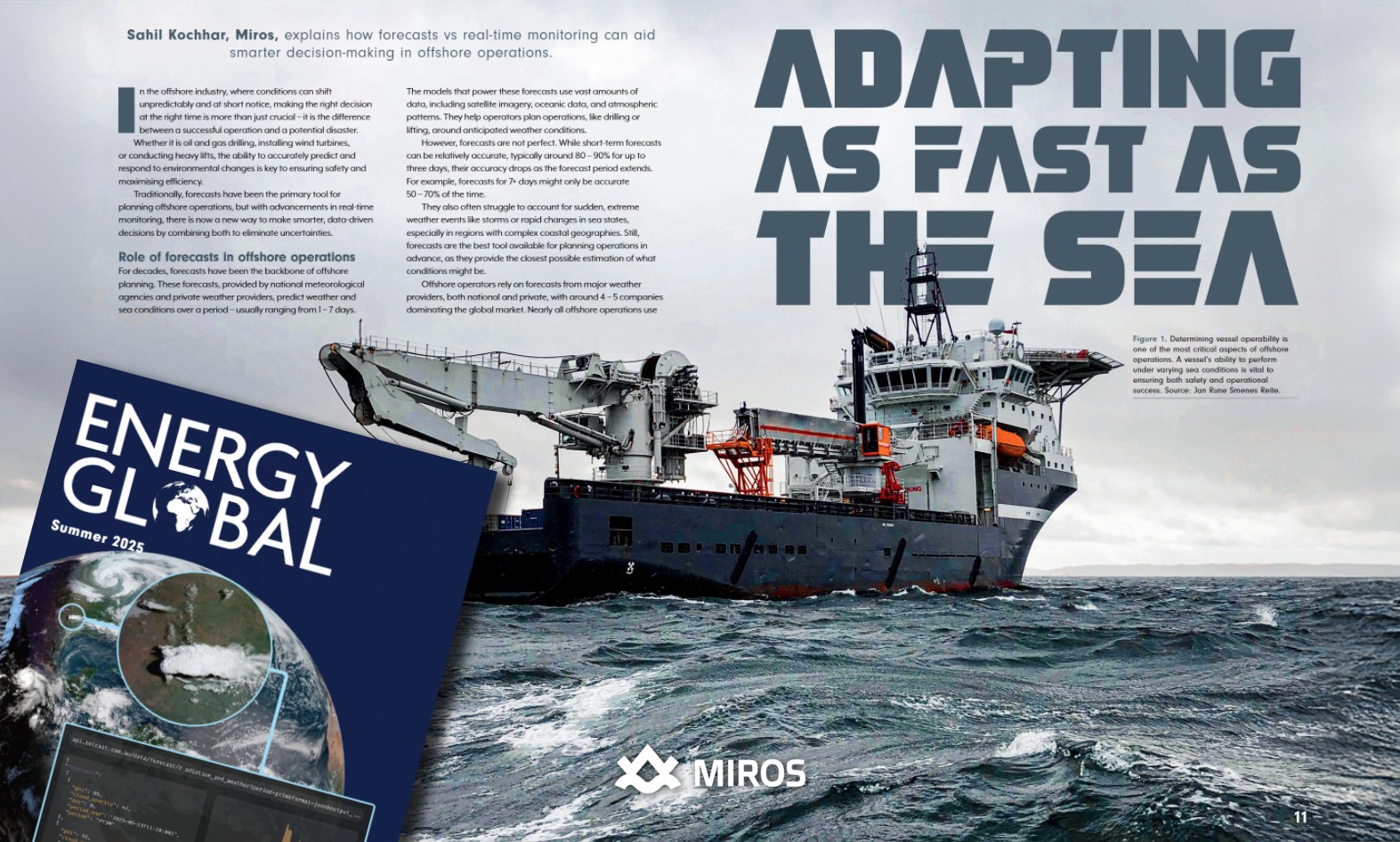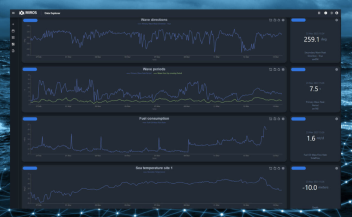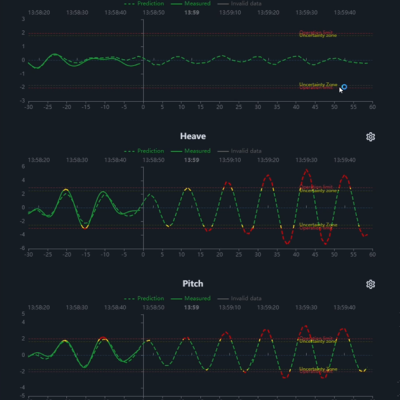Forecasts vs. Real-Time Monitoring: Smarter Decision-Making in Offshore Operations
In the offshore industry, where conditions can shift unpredictably and at short notice, making the right decision at the right time is more than just crucial – it’s the difference between a successful operation and a potential disaster.




Whether it’s oil and gas drilling, installing wind turbines, or conducting heavy lifts, the ability to accurately predict and respond to environmental changes is key to ensuring safety and maximizing efficiency.
Traditionally, forecasts have been the primary tool for planning offshore operations, but with advancements in real-time monitoring, there’s now a new way to make smarter, data-driven decisions by combining both to eliminate uncertainties.
Role of Forecasts in Offshore Operations
For decades, forecasts have been the backbone of offshore planning. These forecasts, provided by national meteorological agencies and private weather providers, predict weather and sea conditions over a period – usually ranging from one to seven days. The models that power these forecasts use vast amounts of data, including satellite imagery, oceanic data, and atmospheric patterns. They help operators plan operations, like drilling or lifting, around anticipated weather conditions.
However, forecasts aren’t perfect. While short-term forecasts can be relatively accurate, typically around 80-90% for up to 3 days, their accuracy drops as the forecast period extends. For example, forecasts for 7+ days might only be accurate 50-70% of the time.
They also often struggle to account for sudden, extreme weather events like storms or rapid changes in sea states, especially in regions with complex coastal geographies. Still, forecasts are the best tool available for planning operations in advance, as they provide the closest possible estimation of what conditions might be.
Offshore operators rely on forecasts from major weather providers, both national and private, with around 4-5 companies dominating the global market. Nearly all offshore operations use one or more forecast services, which are updated several times daily. Despite their limitations, forecasts remain indispensable for planning operations, offering an essential glimpse of what lies ahead.
The Emergence of Real-Time Monitoring
While forecasts give us a predictive look into the future, real-time monitoring offers a live snapshot of current conditions. This technology is rapidly transforming offshore operations by providing continuous, up-to-the-minute data on sea states, wind speeds, and other environmental factors. Real-time monitoring systems use sensors and radar-based technology to measure conditions directly at the site of operation, ensuring that the data is not just accurate but highly specific.
The beauty of real-time monitoring lies in its accuracy. Unlike forecasts, which can provide a broad picture of predicted conditions, real-time systems measure the exact conditions experienced by the vessel or platform at that precise location. These systems allow operators to monitor wave heights, currents, wind speed and direction in real time, adjusting operations on the fly to account for changes in weather that might not have been anticipated. By continuously collecting and analyzing this data, operators can make informed decisions that optimize safety and minimize risks.
For example, radar-based systems like Miros WaveSystem give operators the ability to track conditions directly at the vessel’s location, ensuring that the team is responding to the actual conditions at the site – not the conditions forecasted for a broader area. This ability to make data-driven, real-time adjustments significantly enhances the safety and efficiency of offshore operations.

Today’s Best Practices for Determining Vessel Operability
Determining vessel operability is one of the most critical aspects of offshore operations. A vessel’s ability to perform under varying sea conditions is vital to ensuring both safety and operational success. Traditionally, this has been determined using RAO (Response Amplitude Operators) – a mathematical model that predicts how a vessel will react to waves, wind, and other environmental factors. RAO is based on sea trials and vessel characteristics, offering a very qualified estimation of a vessel’s operability. However, it isn’t perfect. While RAO provides a good theoretical framework, real-world conditions often diverge from the model’s predictions.
Today, determining vessel operability requires a combination of RAO, weather forecasts and historical data. Weather forecasts give operators an outlook on potential sea and wind conditions, while RAO models simulate how the vessel will respond to those conditions. Historical data adds another layer by providing insights from past operations under similar conditions.
However, all these tools, while useful, have limitations. The predictions made by RAO models may not fully capture the impact of extreme weather, or they might not account for minor yet critical variations in real-time conditions. As a result, the accuracy of vessel operability predictions can be improved by combining all these methods with real-time data, which allows for immediate adjustments based on the actual conditions at the site.

Data-Driven Elimination of Uncertainties and Conservatism in Real-Time Using PredictifAI
Real-time monitoring has the potential to drastically reduce the uncertainties and conservatism that often accompany offshore operations. Traditionally, operators have tended to overestimate the risks of certain operations, applying conservative safety margins to account for the unpredictable nature of the sea. While this is a safety measure, it often leads to missed operational opportunities, increased downtime, and wasted resources.
This is where Miros’ PredictifAI® comes into play. By integrating radar-based real-time monitoring systems with artificial intelligence, PredictifAI offers predictive capabilities that go beyond just reporting current conditions. It analyzes real-time data and uses it to predict near-future conditions, enabling operators to make decisions based on what is likely to happen next. PredictifAI can predict both sea conditions and vessel motions up to 2 minutes in advance. Additionally, it also visually presents “Predictions versus Experienced Vessel Motion” without using any models into its analysis. This is an innovative way to look at RAO’s and verify their relevance while conducting operations allowing for more accurate planning and better-informed decisions about when to continue operations or when to pause them.
By combining real-time data with AI-powered predictions, operators can eliminate much of the conservatism that arises from uncertainty. Instead of relying on broad safety margins based on forecasts or RAO models, operators can make more precise decisions, reducing unnecessary downtime and improving overall operational efficiency. PredictifAI’s ability to predict vessel motion and wave behavior in real-time means that operators can adjust their plans on the fly, ensuring that operations are as efficient and safe as possible, even in challenging conditions.

From Reactive to Ready in Real-Time
In offshore operations, where the stakes are high and the environment is unpredictable, making the right decisions is essential. While forecasts have served as the primary tool for planning operations for decades, the rise of real-time monitoring technology offers a more accurate, responsive way to operate in dynamic conditions. By integrating real-time data with traditional forecasting methods, offshore operators can make smarter, data-driven decisions that optimize safety, efficiency, and operational success. Technologies like PredictifAI are helping to eliminate the uncertainty and conservatism that have traditionally characterized offshore decision-making, opening the door to more agile, precise, and proactive operations. As the industry continues to evolve, embracing this new wave of technology will be key to unlocking greater operational excellence in offshore activities.
What risks could you avoid if your strategy adapted as fast as the sea?

